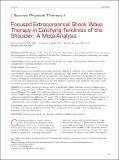| dc.description.abstract | Background:: The objective of this study is to assess the effectiveness of extracorporeal shock wave therapy in the management of calcifying tendinitis of the shoulder. Furthermore, a dose-response relationship was sought as a secondary confirmation of effectiveness. Hypothesis: Focused extracorporeal shock wave therapy has a high, dose-responsive effectiveness in the management of calcifying tendinitis of the shoulder. Study Design: Meta-analysis. Methods: Studies were identified from online databases (MEDLINE, EMBASE, and Cochrane Controlled Trials Register), manual searches, and personal communication with experts in the field. After assessment of heterogeneity, a random effects model was generated. The primary end points were identified as pain and function by using the visual analog scale and the Constant-Murley Score, respectively. These end points were pooled and the weighted mean differences and 95% confidence intervals were estimated. Odds ratios of the secondary end point deposit resorption were pooled. Results:: In 14 studies, shock wave therapy led to a significantly higher reduction of pain (weighted mean difference, −2.8 points; 95% confidence interval, −4.2 to −1.5 points) and improvement of function (weighted mean difference, 19.8 points; 95% confidence interval, 13.4-26.3 points), compared to other treatments and placebo. High-energy treatment produced significantly better results than low-energy treatment for pain reduction (weighted mean difference, 1.7 points; 95% confidence interval, 0.7-2.6 points) and improvement of function (weighted mean difference, 10.7 points; 95% confidence interval, 7.2-14.1 points). These results are consistent with a dose-response relationship supporting the effectiveness of shock wave therapy. Conclusion:: Shock wave therapy for calcifying tendinitis of the shoulder is effective in pain relief, function restoration, and deposit resorption; however, these conclusions are susceptible to bias arising from the limitations of the included studies. | en_US |


